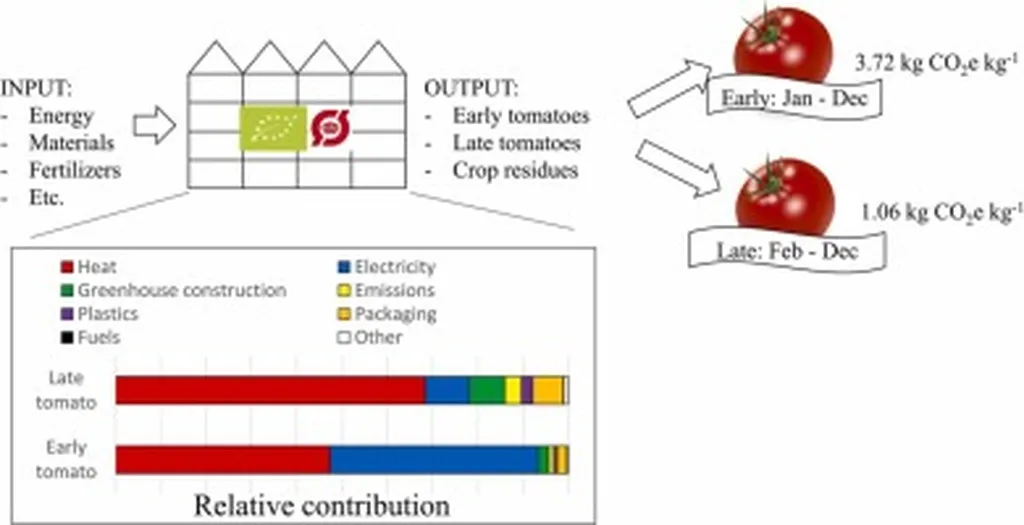In the quest to boost agricultural productivity while minimizing environmental impact, a recent study led by Yanan Sun from the Key Laboratory of Agricultural Soil and Water Engineering in Arid and Semiarid Areas at Northwest A&F University has shed light on the intricate balance between yield and greenhouse gas (GHG) emissions in greenhouse tomato production. The research, published in the journal *Agronomy* (which translates to *Field Cultivation* in English), explores how different combinations of aeration, fertilization, and irrigation levels affect tomato yields and GHG emissions across different seasons.
The study investigated the combined effects of three aeration levels, two fertilization rates, and two irrigation levels on tomato yield and emissions of CO₂, N₂O, and CH₄. The findings revealed that aeration and fertilization significantly increased CO₂ and N₂O emissions but reduced CH₄ emissions. Interestingly, the warmer conditions of the Spring–Summer season elevated all GHG emissions and yield compared to the Autumn–Winter season. Specifically, tomato yield, net GHG emissions, net global warming potential (NGWP), and GHG intensity (GHGI) were 12.05%, 24.3%, 14.46%, and 2.37% higher, respectively, in the Spring–Summer season.
Yanan Sun emphasized the importance of these findings, stating, “Our results provide a theoretical basis for selecting climate-smart management strategies that enhance yield and environmental sustainability in greenhouse tomato systems.” The study identified the optimal practices for different seasons: A1-F1-I1 (single Venturi aeration, lower fertilization, and lower irrigation) in Spring–Summer and A2-F1-I1 (double Venturi aeration, lower fertilization, and lower irrigation) in Autumn–Winter.
The research utilized the Maximal Information Coefficient (MIC) and TOPSIS models to analyze the data, offering a robust framework for decision-making. These models helped identify the most effective combinations of aeration, fertilization, and irrigation levels to maximize yield while minimizing GHG emissions.
The implications of this research are significant for the agricultural sector, particularly for greenhouse tomato producers. By optimizing these management practices, farmers can enhance their yields while reducing their environmental footprint. This is crucial in an era where sustainability and efficiency are paramount.
Moreover, the study highlights the importance of seasonal variations in agricultural practices. Understanding how different seasons affect yield and emissions can help farmers adapt their strategies to achieve the best results throughout the year.
As the world grapples with the challenges of climate change and the need for sustainable agriculture, this research offers valuable insights into how technology and data-driven approaches can be used to optimize agricultural practices. It underscores the potential of combining different management strategies to achieve both economic and environmental goals.
In the broader context, this study could influence future developments in the field of agritech. The use of advanced models like MIC and TOPSIS demonstrates the growing role of data analytics in agriculture. As technology continues to evolve, these models could be integrated into precision agriculture systems, providing real-time recommendations for farmers based on local conditions and seasonal variations.
The research also opens up avenues for further exploration. For instance, investigating the long-term effects of these management practices on soil health and biodiversity could provide a more comprehensive understanding of their sustainability. Additionally, exploring the economic viability of these practices could help farmers make informed decisions about adopting new strategies.
In conclusion, this study by Yanan Sun and colleagues represents a significant step forward in the quest for sustainable agriculture. By providing a detailed analysis of the combined effects of aeration, fertilization, and irrigation on yield and GHG emissions, it offers practical insights for farmers and policymakers alike. As the world continues to seek ways to balance productivity with environmental stewardship, this research serves as a valuable guide for the future of greenhouse tomato production and beyond.

